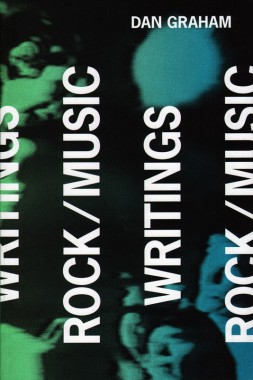
Dan Graham, Rock/Music Writings
Softcover, 224 pp., offset 4/1, 5.5 x 8.25 inches
Edition of 3000
ISBN 978-0978869-73-1
Published by Primary Information
$18.00 ·
As admired for his writing as for his work in art, photography and architecture, Dan Graham was one of the first contemporary artists to embrace Punk, Postpunk and No Wave, becoming a figurehead for those movements, and an early supporter of (and friend to) Glenn Branca and Sonic Youth among many others. Rock/Music Writings collects 13 of Graham’s most influential writings, on bands ranging from The Kinks to Bow Wow Wow, first published in art journals such as Real Life, Open Letter and ZG between 1968 and 1988, and in the now rare volume Rock My Religion. It includes such landmark essays as “Punk as Propaganda,” which explicates the self-packaging and media critique of The Ramones, Devo, the Sex Pistols, the Desperate Bicycles and others; “Rock My Religion,” in which Graham traces themes of ecstatic reverie in rock performance (with a focus on Patti Smith), through a beautiful composite of quotation, commentary and photography; and “New Wave Rock and the Feminine,” which discusses the onstage personae of Lydia Lunch, Debbie Harry and Siouxsie Sioux, and the gender politics of all-female groups such as The Slits, The Raincoats, Bush Tetras and others. Throughout Rock/Music Writings, Graham’s appraisals are clear-eyed, sophisticated and poetically constructed, a genre of their own within artists’ writings.
Art, Culture, Dan Graham, DAP, Debbie Harry, Glenn Branca, Lydia Lunch, Music, Primary Information
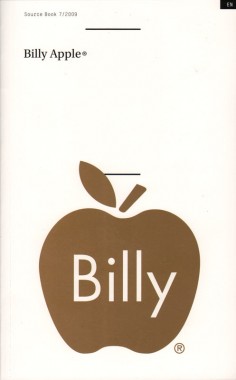
Zoë Gray, Nicolaus Schafhausen and Monika Szewczyk, Billy Apple
Softcover, 112 pp., offset 4/1, 125 x 200 mm
Edition of 1000
ISBN 978-90-73362-89-5
Published by Witte de With
$15.00 ·
Billy Apple was created in 1962 as a work by the New Zealand-born artist Barrie Bates, who changed his name to become a living brand after graduating from London’s Royal College of Art. For this volume, four writers combine to discuss the brand, providing a chronology, a contextualization of Apple’s practice within institutional critique and his enduring significance for younger generations.
Art, Barrie Bates, Bénédicte Ramade, Billy Apple, Christina Barton, DAP, Michelle Menzies, Monika Szewczyk, Nicolaus Schafhausen, William Wood, Witte de With, Zoë Gray
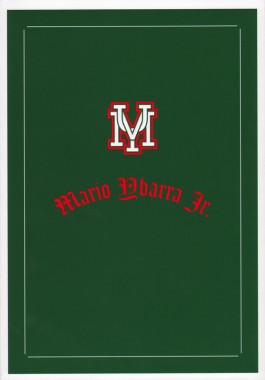
Mario Ybarra Jr., Capp Street Project
Softcover, 48 pp., offset 4/2, 6.5 x 9.25 inches
Edition of 1000
ISBN 978-0-9725080-7-0
Published by CCA Wattis Institute of Contemporary Art
$12.00 ·
When referred to as a Chicano artist in the Los Angeles Times, Mario Ybarra Jr. once protested, “I make contemporary art that is filtered through a Mexican-American experience in Los Angeles.” Filled with graffiti, restaurant signage and stills from music videos, with sweeping graphic lines and lyric abstractions, his outrageous, multicolored murals speak about his particular experience as an artist and a Mexican-American, both politically and aesthetically. Compactly designed by Jon Suede/Stripe, this slim, dynamic catalogue with paper changes features an essay on the artist’s entire oeuvre by Jens Hoffmann, along with an engaging text by Claire Fitzsimmons. Produced to accompany Ybarra’s installation at San Francisco’s Capp Street Project, this volume is the artist’s first monograph, as well as a thorough document of the mural he produced over the course of his residency there.
Anna Helwing Gallery, Art, Capp Street Project, CCA Wattis Institute of Contemporary Art, Claire Fitzsimmon, DAP, Jens Hoffman, Mario Ybarra Jr.
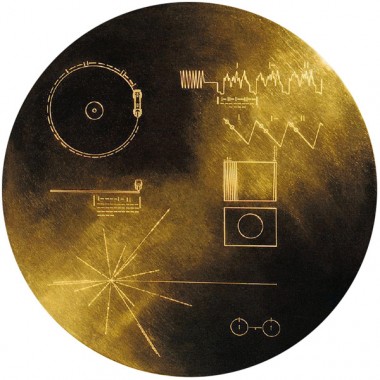
Carl Sagan, The Voyager Interstellar Record (& Book Cover), 1977
We’re proud to announce that Textfield, Inc. has been selected this week as the featured store on the Artbook/D.A.P. website, scroll down below “featured book” (The Ferus Gallery: A Place to Begin).
Thanks to Avery and Cory at
D.A.P.Artbook, Bookshop, DAP, Textfield
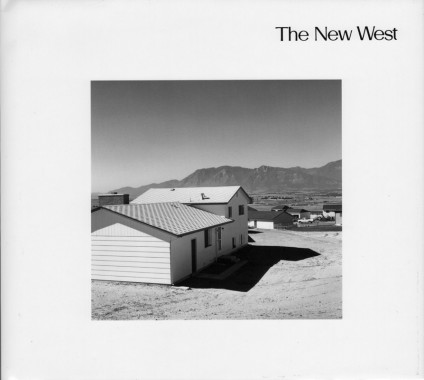
Robert Adams, The New West
Softcover, 136 pp., offset 1/duotone, 260 x 230 mm
Edition of 2000
ISBN 9781597110600
Published by Aperture
$45.00 ·
Originally published in 1974, Robert Adams’ The New West signaled a paradigm shift in the photographic representation of American landscapes. Foregoing photography’s traditional role of romanticizing the Western landscape, Adams focused instead on the construction of tract and mobile homes, subdivisions, shopping centers and urban sprawl in the suburbs of Colorado Springs and the Denver area. Adams transmuted these zones with his minimalist vision of their austerity; as he has noted, “no place is boring, if you’ve had a good night’s sleep and have a pocket full of unexposed film.” Objective and direct, Adams’ photographs, rendered in his signature middle-gray scale, unsentimentally depict a despoiled landscape washed in the intense Colorado sunlight. Today The New West stands alongside Walker Evans’ American Photographs, Robert Frank’s The Americans and Stephen Shore’s Uncommon Places in the pantheon of landmark projects on American culture and society. This second reissue of the classic publication has been recreated from Adams’ original prints.
Aperture, Art, DAP, John Szarkowski, Photography, Robert Adams, Robert Frank, Stephen Shore, Walker Evans
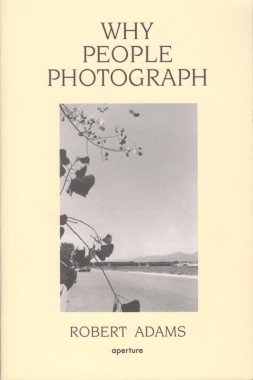
Robert Adams, Why People Photograph
Softcover, 189 pp., offset 1/1, 5.5 x 8.25 inches
Edition of 2000
ISBN 9780893816032
Published by Aperture
$15.00 ·
A now classic text on the art, Why People Photograph gathers a selection of essays by the great master photographer Robert Adams, tackling such diverse subjects as collectors, humor, teaching, money and dogs. Adams also writes brilliantly on Edward Weston, Paul Strand, Laura Gilpin, Judith Joy Ross, Susan Meiselas, Michael Schmidt, Ansel Adams, Dorothea Lange and Eugène Atget. The book closes with two essays on “working conditions” in the nineteenth- and twentieth-century American West, and the essay “Two Landscapes.” Adams writes: “At our best and most fortunate we make pictures because of what stands in front of the camera, to honor what is greater and more interesting than we are.”
Ansel Adams, Aperture, Criticism, DAP, Dorothea Lange, Edward Weston, Eugène Atget, Judith Joy Ross, Michael Schmidt, Paul Strand, Photography, Robert Adams, Susan Meiselas, Theory
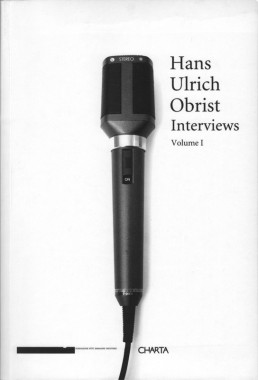
Hans Ulrich Obrist, Interviews Volume I
Softcover, 968 pp., offset 1/1, 140 x 205 mm
Edition of 2000
ISBN 9788881584314
Published by Charta
$59.00 ·
It is not an exaggeration to write that Hans Ulrich Obrist is everywhere, has curated everything and has interviewed everyone. If “peripatetic” is the word most overused to describe him, it is not inappropriate. The Swiss-born, everywhere-based curator and head of the Programme Migrateurs at the Musée d’Art Moderne de la Ville de Paris has an unstoppable wanderlust and a related symptom: his penchant for interviewing anyone and everyone who piques his curiosity, be they artist, scientist, writer, curator, composer, architect, thinker, etc. Since 1993, Obrist has conducted more than 300 interviews, 75 of which are collected here in a selection that respects the cultural and professional diversity of the interviewees. Each interview is introduced by a short text outlining the biography of the interviewee and giving some contextual information on the recording of the interview.
Art, Brian Eno, Charta, Daniel Buren, DAP, Felix Gonzalez-Torres, Gerhard Richter, Hans Ulrich Obrist, Interviews, Jonas Mekas, Lawrence Weiner, Mario Merz, Matthew Barney, Maurizio Cattelan, Olafur Eliasson, Rem Koolhaas, Vito Acconci, Walter Hopps, Yoko Ono, Zaha Hadid
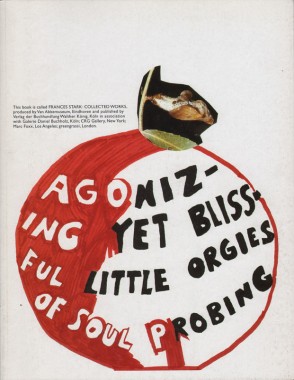
Frances Stark, The Collected Works
Softcover, 160 pp., offset 4/1, 220 x 280 mm
Edition of 2000
ISBN 978386560263
Published by Walther König
$54.00 · out of stock
The Los Angeles-based artist and art writer Frances Stark has gathered an international cult following for her prolific prose and her smart, honest and intimate artwork. This engaging artist’s book is conceived as a companion piece to Stark’s Collected Writings 1993–2003, fashioning itself as a graphic counterpart that draws from the artist’s paintings, collages, drawings, videos, poetry and more, from 1993 to the present. Through provocative and diaristic text notes printed alongside Stark’s sometimes humorous, often self-scrutinizing images, The Collected Works addresses the paradox of reproducing visual art that is essentially non-photogenic by nature — because of its tactility, detail or scale. The book formally addresses how verbiage flows in and out of the work(s), and leaves no space for the legitimizing language of the critic or curator. Neither a typical catalogue nor monograph, it pushes for a third form, a new art work constructed from existing pieces.
Art, DAP, Frances Stark, Galerie Daniel Buchholz, Marc Foxx, Van Abbemuseum, Walther König

Robert Venturi, Complexity And Contradiction In Architecture
Softcover, 136 pp., offset 1/1, 11 x 8.5 inches
Edition of 5000
ISBN 9780870702822
Published by MoMa
$20.00 ·
First published in 1966, and since translated into 16 languages, this remarkable book has become an essential document of architectural literature. A “gentle manifesto for a nonstraightforward architecture,” Venturi’s Complexity and Contradiction in Architecture expresses in the most compelling and original terms the postmodern rebellion against the purism of modernism. Three hundred and fifty architectural photographs serve as historical comparisons and illuminate the author’s ideas on creating and experiencing architecture.
Architecture, Arthur Drexler, Criticism, DAP, MoMa, Robert Venturi, Vincent Scully
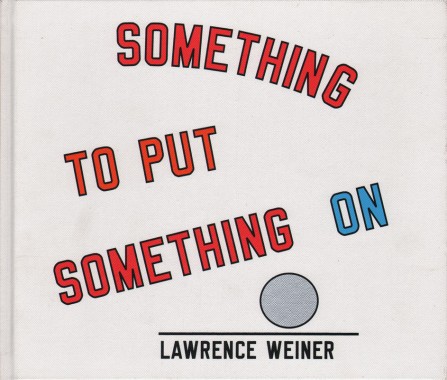
Lawrence Weiner, Something To Put Something On
Hardcover, 44 pp., offset 4/4, 255 x 215 mm
Edition of 5000
ISBN 9783865214911
Published by Steidl
$35.00 ·
Something to Put Something On poses direct questions about art-making to and for young readers. Generously endowed with its maker’s legendary wit, it is also, appropriately, the first title in the Little Steidl program. Neither storybook nor autobiography,
Something to Put Something On is rather a “questioning book” for children, at once moving and intriguing in its candor:
I WAS A CHILD & AS MOST CHILDREN I DID MAKE THINGS
I TRIED TO FIND A PLACE TO PUT THE THINGS I HAD MADE
AGAIN & AGAIN I FOUND THAT THE SUPPORT OR PLINTH OR TABLE
ALL RESTED UPON THE EARTH & I REALIZED THAT ALL PEOPLE OF ALL AGES
WHO HAD MADE SOMETHING HAD TO FIND A PLACE TO PUT
WHAT THEY HAD MADE
THOSE PEOPLE WHO ASK THE QUESTION & THOSE PEOPLE WHO TRY
TO ANSWER THE QUESTION ARE FUNCTIONING AS ARTISTS.
I WAS A CHILD & DECIDED TO BE AN ARTIST.
—Lawrence Weiner
Art, DAP, Education, Jerry Sohn, Lawrence Weiner, Margaret Seaworthy Gothic, Nina Holland, Simon Johnson, Steidl
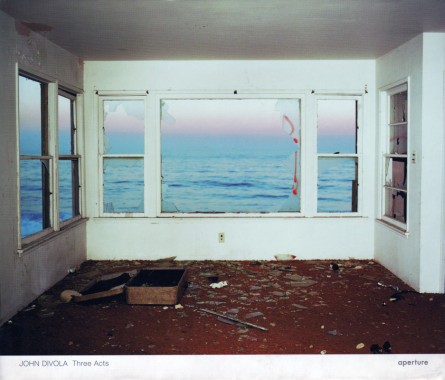
John Divola, Three Acts
Hardcover, 144 pp., offset 4/duotone, 11 x 9.25 inches
Edition of 2000
ISBN 9781931788953
Published by Aperture
$50.00 ·
In 1973, California artist John Divola began the first of three highly ambitious and original bodies of work that form Three Acts, the first book dedicated to them. His Vandalism series comprises black-and-white photographs of interiors of abandoned houses. Entering illegally, Divola spray-painted markings that referenced action painting as readily as the graffiti that was then becoming a cultural phenomenon. For the following year’s Los Angeles International Airport Noise Abatement series, he photographed a condemned neighborhood bought out to serve as a noise buffer for new runways, focusing on evidence of previous unsanctioned entries by other vandals. His final work, Zuma, documents the destruction of an abandoned beachfront property by the artist and others, as it deteriorates frame by frame and eventually burns. Divola has much in common with artists such as Bruce Nauman and Robert Smithson who have used photography to investigate other topics. He describes his innovative practice succinctly: “My acts, my painting, my photographing, my considering, are part of, not separate from, this process of evolution and change. My participation was not so much one of intellectual consideration as one of visceral involvement.”
Aperture, Art, DAP, David Campany, Francesca Richer, Jan Tumlir, John Divola, Michael Famighetti, Photography
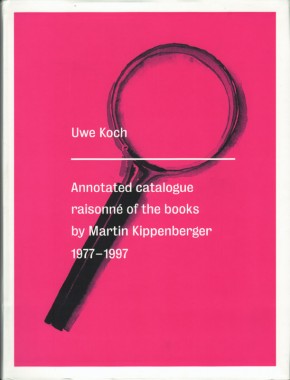
Martin Kippenberger, Annotated Catalogue Raisonné of the Books by Martin Kippenberger 1977-1997
Softcover, 368 pp., offset 1/1, 8.25 x 11 inches
Edition of 5000
ISBN 9781891024658
Published by Distributed Art Publishers
$55.00 ·
Roberta Smith called him the “madcap bad boy of contemporary German art” and also “one of the three or four best German artists of the postwar period.” Martin Kippenberger disrupted the status quo throughout his brief, excessive life, not just by making art of every variety and medium but also by conducting an extended performance in the vicinity of art that involved running galleries, organizing exhibitions, collecting the work of his contemporaries and overseeing assistants. He published books and catalogues, played in a rock-and-roll band and cut records, ran a performance-art space during his early years in Berlin, became part owner of a restaurant in Los Angeles during six months he spent there preparing for an exhibition, and collaborated extensively with other artists. This particular volume considers his output of artist’s books, as well as his exhibition catalogues and all the publications whose content he either created or edited. More than just documentation, this publication makes accessible for a wider public the multiple aspects of Kippenberger’s books, with all the complexity and consequence of his oeuvre intact.
Alex Katz, Art, DAP, Diedrich Diederichsen, Distributed Art Publishers, Martin Kippenberger, Roberto Ohrt, Typography, Uwe Koch
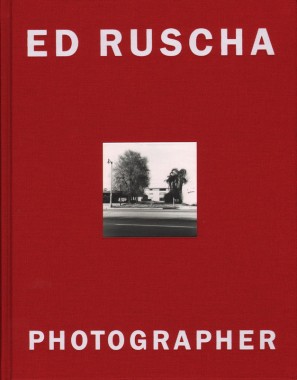
Ed Ruscha, Ed Ruscha Photographer
Hardcover, 184 pp., offset 4/1, 225 x 260 mm
Edition of 2000
ISBN 9783865212061
Published by Steidl
$35.00 · out of stock
Ed Ruscha’s relationship to photography is complex and ambivalent. The world-class painter — and author of a 1972 New York Times article called “‘I’m Not Really a Photographer’” — has been known to refer to his work in this second medium as a “hobby,” despite considerable, persistent critical interest. Whether he likes it or not, the small albums of plainly-shot, snapshot-sized images he produced in the 1960s and 70s, including Twenty-Six Gasoline Stations, intrigued his contemporaries and earned him an unshakable reputation. How? His subject matter was neither purely documentary nor solely artistic, in fact it was stereotypical and banal, with motifs drawn from the car-dominated western landscape. That rebellious material, along with his serial presentation, made for a mythical road-movie or photo-novel effect with Beat Generation overtones. The combination attracted artists and critics both, especially while serial logic was prominent in Pop art and Minimalism, and then retained that interest later as serial work became prominent in Conceptual art. Critics have remained attentive for decades, and Ruscha’s influence remains apparent in new work in Europe and North America. Ed Ruscha, Photographer departs from earlier collections to explore how these images — and all of Ruscha’s work in disciplines including painting, drawing, printmaking and photography–are guided and shaped by a single vision.
Art, DAP, Ed Ruscha, Lynn Scrabis, Makiko Ushiba, Photography, Steidl, Thea Hetzner, Whitney Museum












